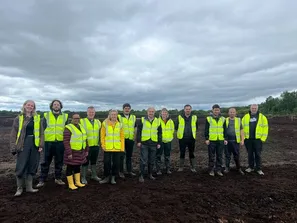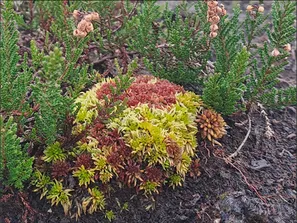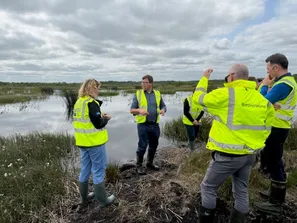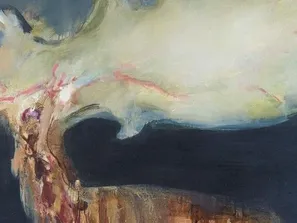23 Apr 2024
We are starting a new series of articles where we introduce the people that make EU LIFE Integrated Project Peatlands and People. Meet David McNicholas, Ecologist - Rehab Design & Verification at Bord na Móna.
Can you tell us a bit about your background and what led you to work as an ecologist?
Growing up in the countryside in North Mayo, on the shores of Lough Conn, I developed a passion for all things wildlife. I spend many hours of my youth exploring the nearby lakeshore and the hay meadows of our small farm. Birdwatching became a particular interest of mine and I recall seeing flocks of wintering Greenland white-fronted goose (now unfortunately very scarce in the area), wintering Curlew and an array of breeding countryside birds. This passion followed me through my Degree in Environmental Science at Sligo IT (Atlantic Technological University Sligo). There I was lucky enough to study and undertake my final year thesis with Dr. Don Cotton. Don was a very passionate naturalist who was generous with his time and encouraged me to follow my passion for all things ecology. Following completion of an M.Sc. in Environmental, Health & Safety Management, I worked in Ecological Consultancy for 10 years before joining Bord na Mona.
What partner are you part of?
I work for Bord na Móna who are coordinating LIFE Peatlands and People. Bord na Móna are responsible for implementing much of the rehabilitation and restoration measures and will deliver this via Pillar 1: “Peatlands Excellence” - A network of peatland sites will be established to explore best practices in restoration and rehabilitation and design robust methodologies to monitor and analyse carbon storage.
What is your role in the project?
Working on the Sphagnum moss inoculation project, my primary roles include project implementation, the provision of ecological guidance as well as the design and implementation of the ecological monitoring requirements. This role is wide ranging which I enjoy; providing opportunities for collaboration with many other disciplines including project engineers, operation teams who plant the Sphagnum moss, collaboration with other scientific researchers i.e. Bord na Móna’s Carbon Monitoring Team, as well as an array of stakeholders including Department regulators and the public.
What is your aspiration for the project?
Ultimately, the Pillar on Peatland Excellence aims to expediate the colonisation and establishment of typical Sphagnum moss species on former industrial peat extraction sites. The end goal is to accelerate the process of active bog formation where conditions occur and ultimately achieve carbon sequestration on these peatlands. This will also have significant biodiversity benefits, creating peatland habitats that will support a wide array of flora and fauna.
I am passionate about nature restoration and strive to implement best practice to ensure the best outcome for peatland restoration and all of its associated benefits. The implementation of this scheme provides a unique opportunity for enhanced peatland restoration which is likely the largest of its kind in Europe. This provides opportunities for testing the planting of Sphagnum moss across many environmental variables i.e. within different rehabilitation methodologies, differing residual peat depths, water chemistry and many more. The results of the Monitoring Protocol will provide a useful study that will inform future enhanced peatland rehabilitation projects.
What is your favourite peatlands memory?
Although I enjoy spending time on my own or in a buddy system with a colleague surveying wildlife or vegetation on peatlands (this provides a great sense of exploration in wild places). I thoroughly enjoy spending time with other colleagues and friends exploring these unique habitats. Any day spend on a peatland with other experts or enthusiasts will always result in you taking home some new nugget of information. I have had lucky enough to spend some amazing days with both Bord na Móna and other peatland specialists.
Can you elaborate on the importance and impact of rehabilitated peatlands?
- Often remote areas providing space for nature.
- Creates large wild spaces for nature.
- It is important for a wide range of common and threatened species.
A good example of some of the benefits of peatland restoration is the return of breeding Common crane in Ireland. The first confirmed breeding attempt by a pair of Common crane occurred in 2019, with further attempts in 2020 and 2021. This breeding site is located on a revegetated Bord na Móna cutover bog in Co. Offaly. The pair are known to have now fledged at least three young over the last two years (two chicks in 2022 and one chick in 2023). This demonstrates the value of such wild places, even though the secondary habitats now establishing do not resemble those of the original raised bog.
What is your favourite species found in peatlands?
It is difficult to choose a single species, given the unique and unusual array of species that are unique to peatlands, ranging from birds, mammals, invertebrates, vascular plants, mosses and other bryophytes. However, one of my favourite species is Bog asphodel (Nartheciumossifragum). The scientific name for the species "ossifragum" means “bone breaking”. This is thought to be derived from the fact that animals grazing in the bogs where the Bog asphodel thrives i.e. wet conditions, would suffer from foot rot and the lack of calcium available from the plant species growing on the peat.
This species flowers between June, July and August, although its flowering spikes persist throughout the year, making it easy to identify. The flower colours start out as a brilliant yellow, before turning to a rusty colour in late summer and autumn. This gives a striking splash of colour on what can sometimes look like heather dominated vegetation. This species occurs on intact raised bogs and blanket bogs. Where suitable conditions occur, this species also occurs on revegetated cutover bogs. The below photo was taken on Belmont bog, Co. Offaly. This bog has revegetated post industrial peat extraction and supports an array of interesting secondary habitats. This bog has been subject to rehabilitation (drain blocking and water management) as part of Bord na Móna’s Peatlands Climate Action Scheme (PCAS).
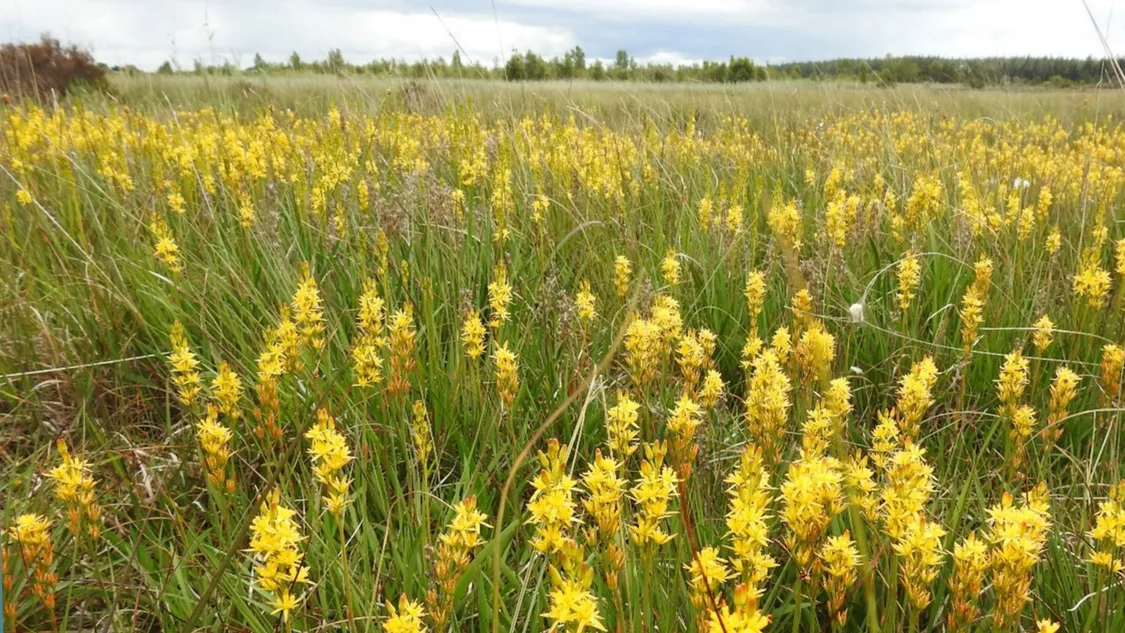
Photo of Bog asphodel in flower in July at Belmont Bog, Co. Offaly.
Do you see opportunity in Ireland to further develop peatland knowledge and best practices?
Irish peatlands provide a great resource for further research. It is important that we not only understand the functioning of our most important “intact” peatlands, but also learn from recent and developing rehabilitation and restoration techniques that have been implemented in recent years. It will be important to monitor the successes and challenges in peatland rehabilitation and restoration in order to develop best practice methodologies and guidance. Given the extensive areas of peatlands occurring in Ireland (peatlands cover 17.2% of the land mass of the Republic of Ireland), there is also a need to develop further the number of professional ecologists, hydrologists, engineers and restoration specialists (machinery operators) in order to meet Ireland's ambitions in peatland restoration.
Do you have any suggestions for how people at home can support peatland protection and rehabilitation?
Explore your local bog, and or become more familiar with the unique habitats and species they support. I believe that this will further develop anyone’s passion for peatlands.
There are many ways in which people can now engage in citizen science; be it via a local wildlife group, attending Heritage Week events, partaking in voluntary surveys via the National Biodiversity Data Centre (NBDC) etc. Such activities can provide great opportunities for developing ones understanding of peatland ecosystems and the array of services they offer. When we value these habitats, the species they support, all the other ecosystem services, and the international importance of the peatlands occurring in Ireland, this will help in increasing their protection and rehabilitation/ restoration.


